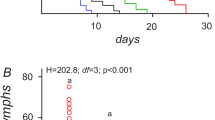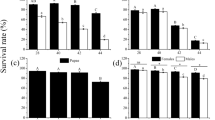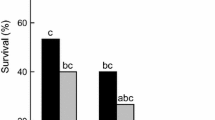Abstract
Trichogramma brassicae Bezdenko (Hym., Trichogrammatidae) is a parasitoid used for controlling the European corn borer,Ostrinia nubilalis Hübner (Lep., Pyralidae). In parts of south-eastern France, the parasitoids may be placed under a shelter when they are in the prepupal stage for diapause termination, before they are released among the crops. High temperatures (31°C–32°C) can occur during this period.
Prepupae were exposed to one or two high temperature shocks at 32°C in the laboratory, and the effects of these shocks were then recorded on a number of biological parameters of the parasitoids belonging to the experimental generation Go and to the progeny generation G1.
The emergence rate of Go individuals was highly affected, even when the prepupae had been exposed to a single shock. This decreased the number of parasitoids, in addition to reducing the fecundity of the females. The temperature shocks also affected the emergence rate of generation G1. No changes were observed regarding the other parameters (minimum duration of final pupal development, longevity, proportion of females). A temperature shock, even a short-lasting low amplitude one, may thus have strong implications on the efficiency of the parasitoids.
Résumé
Trichogramma brassicae Bezdenko (Hym., Trichogrammatidae) est un parasitoïde utilisé dans la lutte contre la pyrale du maïs,Ostrinia nubilalis Hübner (Lep., Pyralidae). Dans certaines régions du Sud Est de la France, les trichogrammes, souche diapausante, sont mis sous abri au stade prénymphe, avant d’être lâchés dans les cultures. On observe alors des pics de température à 31 °C–32 °C.
Un ou deux chocs de température à 32 °C ont été appliqués au laboratoire à l’âge prénymphe et leurs conséquences sur divers paramètres biologiques des parasitoïdes ont été observées (génération traitée G0 et sa descendance génération G1). Le taux d’émergence des individus de la génération G0 a été nettement affecté, même par un seul choc de température. Il en découle une diminution de l’effectif des parasitoïdes, à laquelle s’ajoute une fécondité moindre des femelles. Les chocs de température ont aussi affecté le taux d’émergence de la génération G1. Les autres paramètres (durée minimale de fin de développement, longévité, proportion de femelles), ne semblent pas modifiés. Ainsi un choc de température, même de faible amplitude et de courte durée, peut avoir des répercussions importantes sur l’efficacité des parasitoïdes.
Similar content being viewed by others
References
Cabello, T. &Vargas, P. — 1988. The effect of temperature on the bionomics ofTrichogramma cordubensis (Hym.: Trichogrammatidae). In,Trichogramma and other egg parasites, 2nd international Symposium, Guangzhou (China). Vol. 43, pp. 155–164. Les Colloques de l’INRA, INRA, Paris.
Chihrane, J. &Laugé, G. — 1996. Loss of parasitization efficiency ofTrichogramma brassicae (Hym.: Trichogrammatidae) under high temperature conditions. —Biol. Control 7, 95–99.
Chihrane, J., Derrien, A. & Laugé, G. — 1997. Locomotory activity ofTrichogramma brassicae (Hymenoptera) under the influence of high temperature shocks. —J. Insect Behavior (in press).
Chihrane, J., Laugé, G. &Hawlitzky, N. — 1993. Effects of high temperature shocks on the development and biology ofTrichogramma brassicae (Hym.: Trichogrammatidae). —Entomophaga, 38, 185–192.
Ciochia, V., Isac, G. &Stan, G. — 1993. Tehnologii de crestere industrialà a citorva specii de insecte auxiliare folosite in combaterea biologicà a dàunàtorilor.Editura Ceres, Bucuresti, 248 p.
Cohet, Y. &David, J. — 1978. Control of the adult reproductive potential by preimaginal thermal conditions. A study inDrosophila melanogaster. —Oecologia (Berl.), 36, 295–306.
Dutton, A., Cerutti, F. &Bigler, F. — 1996. Quality and environmental factors affectingTrichogramma brassicae efficiency under field conditions. —Entomol. exp. appl., 81, 71–79.
Frandon, J. & Kabiri, F. — 1990. La lutte biologique avec les Trichogrammes contre la deuxième génération de la pyrale du mais.ANPP, 2e Conf. int. Ravageurs en Agriculture, 1217–1224.
Frenoy, C. — 1990. Mise en évidence, rôle et nature de kairomones émises par la Pyrale du maïs,Ostrinia nubilalis (Lepidoptera, Pyralidae), sur le comportement deTrichogramma brassicae (Hymenoptera, Trichogrammatidae) utilisé en lutte biologique. Th. Doct. en Sciences, Univ. Paris XIII, 142 p.
Fye, R.E. &Larsen, D.J. — 1969. Preliminary evaluation ofTrichogramma minutum as a released regulator of Lepidopterous pests of cotton. —J. Econ. Entomol., 62, 1291–1296.
Gross, H.R. — 1988. Effect of temperature, relative humidity, and free water on the number and normalcy ofTrichogramma pretiosum Riley (Hymenoptera: Trichogrammatidae) emerging from eggs ofHeliothis zea (Boddie) (Lepidoptera: Noctuidae). —Environ. Entomol., 17, 470–475.
Lopez, J.D. &Morrison, R.K. — 1980. Effects of high temperatures onTrichogramma pretiosum programmed for field release. —J. Econ. Entomol., 73, 667–670.
Maignet, P. — 1989. Effet d’un séjour à basse température subi par des adultes deTrichogramma brassicae Bezdenko (Hym. Trichogrammatidae) prêts à émerger, après reprise du développement préimaginal en températures alternées, sur leurs caractéristiques biologiques. Mémoire D.E.A., Univ. Paris-XI, 26 p.
Pintureau, B. — 1990. Polymorphisme, biogéographie et spécificité parasitaire des Trichogrammes européens (Hym. Trichogrammatidae). —Bull. Soc. Ent. Fr., 95, 17–38.
Rojas-Rousse, D. — 1981. Conséquences d’une augmentation des températures dans un cycle thermopériodique sur la reproduction d’entomophages parasitoïdes. —Bull. Soc. Zool. Fr., 106, 407–417.
Russo, J. &Voegelé, J. — 1982. Influence de la température sur quatre espèces de trichogrammes (Hym. Trichogrammatidae) parasites de la pyrale du maïs,Ostrinia nubilalis Hubn. (Lep. Pyralidae). I. — Développement préimaginal.Agronomie, 2, 509–516.
Russo, J. &Voegelé, J. — 1982. Influence de la température sur quatre espèces de trichogrammes (Hym. Trichogrammatidae) parasites de la pyrale du maïs,Ostrinia nubilalis Hubn. (Lep. Pyralidae). II. — Reproduction et survie.Agronomie, 2, 517–524.
Voegelé, J., Pizzol, J., Raynaud, B. &Hawlitzky, N. — 1986. La diapause chez les Trichogrammes et ses avantages pour la production de masse et la lutte biologique. —Med. Fac. Landbouww. Rijksuniv. Gent, 51, 1033–1039.
Volkoff, A. N., &Daumal, J. — 1994. Ovarian cycle in immature and adult stages ofTrichogramma cacoeciae andT. brassicae (Hym.: Trichogrammatidae). —Entomophaga, 39, 303–312.
Wajnberg, E. — 1993. Genetic variation in sex allocation in a parasitic wasp: variation in sex pattern within sequences of oviposition. —Entomol. exp. appl., 69, 221–229.
Author information
Authors and Affiliations
Rights and permissions
About this article
Cite this article
Gunie, G., Laugé, G. Effects of high temperatures recorded during diapause completion ofTrichogramma brassicae prepupae (Hym.: Trichogrammatidae), on the treated generation and its progeny. BioControl 42, 329–336 (1997). https://doi.org/10.1007/BF02769825
Received:
Accepted:
Published:
Issue Date:
DOI: https://doi.org/10.1007/BF02769825




